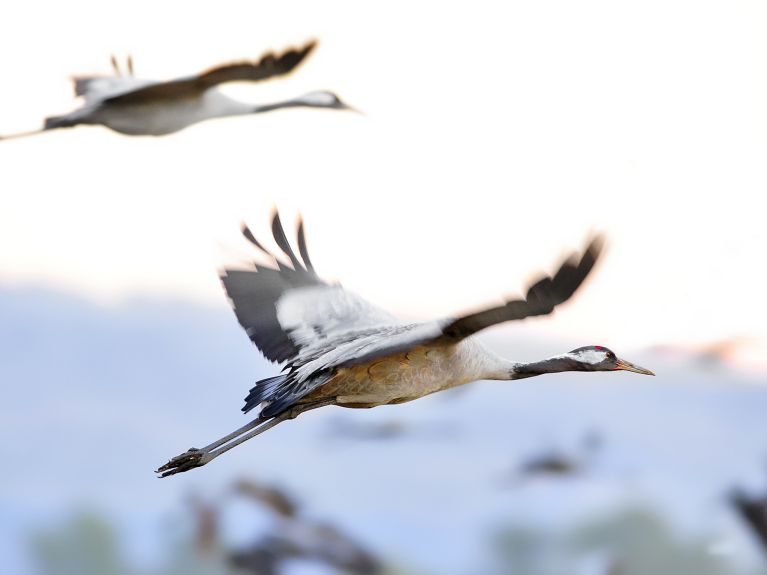The bird of good fortune makes its journey
Thousands of cranes stopover in Israel every year. A German-Israeli project aims to combine nature conservation, agriculture and tourism.

Good fortune, happiness, peace, vigilance, wisdom: For thousands of years people have associated positive traits with the crane. The large flocks in northern and eastern Germany still attract many tourists to this day – as does Israel’s Hula Valley, where the birds from eastern Europe spend the winter. The project “Kranich auf Reisen” (Travelling Crane) is supported by the German-Israeli Future Forum (DIZF) and involves ten participants each from the German Naturschutzjugend (Youth Association for the Protection of Nature, NAJU) and Israeli Society for the Protection of Nature (SPNI) as well as two full-time staff members from the organisations. In the context of intercultural dialogue they focus on the symbolic value of the migratory bird and seek to draw attention to current challenges, namely by combining nature conservation, agriculture and tourism.

German-Israeli tandems
“NAJU and SPNI have been in dialogue for several years now, as both organisations consider the education of children and young people a priority,” notes Nadav Israeli, who coordinates the project for SPNI. “Kranich auf Reisen” is also part of the educational drive for sustainable development: “In the context of German-Israeli tandems we have developed a brochure that playfully informs readers about various facets of the crane – its appearance, mythological significance, the threats it faces and measures to protect it,” says the German project leader Manuel Tacke, responsible for international affairs at NAJU. “We will use the collection of materials in schools, playschools and events with children and young people.”
Two workshops, work shadowing, and an online platform bring the participants together – and strengthen them in their objective to get young people committed to nature protection: “It’s been great seeing people in Israel with the same passion fighting for the same cause and facing similar problems, even if they are rooted in a different cultural context,” comments Tacke. For despite increasing overall numbers in Europe, the crane is threatened by habitat destruction. Tourism is also posing a problem: “The more the birds are startled and take flight, the more energy, i.e. food, they need,” explains Manuel Tacke.
The Hula Valley as a resting place
This is a big problem, because in addition to insects, worms, small fish and frogs, the birds feed on grains of corn and other cereals as well as beans, peas and peanuts, among other things. It is farmers who suffer from this, having to contend with considerably reduced harvests. SPNI, the largest nature protection organisation in Israel, has found a remedy. “Around 45,000 cranes stopover in the Hula Valley every year,” reports Nadav Israeli. “To prevent them plundering the fields, we feed them from December to February at selected spots.” In the course of the “Kranich auf Reisen” project he observed the fascinating migratory birds together with the German-Israeli team in the Hula nature reserve and benefited, like his German colleagues, from new ideas for the educational work. It is not least for this reason that the collaboration, which ends in November 2018 after two years, is to be continued – with a further exciting project starting in 2019.
These two women are involved in the collaborative German-Israeli project:

Yael Lehnardt from Jerusalem is an environmental educator for SPNI
“I work as a coordinator of the Israeli Youth Birding Clubs for SPNI. It was the opportunity to swap experiences with other environmental educators that particularly interested me about the ‘Kranich auf Reisen’ project. The greatest challenge was understanding how big the differences are between the groups we work with and how that influences our educational work. Of the many positive experiences I’ve had, the excursion to the Hula nature reserve stands out especially. There we not only swapped our experiences with educational programmes, but also shared our knowledge about the nature we are trying to preserve with the aid of our programme. I was impressed by how similar the German and Israeli nature conservationists are in terms of their motivation, experiences and goals – and the commitment of the young people involved in our bird clubs.”
Anja Zimmermann heads the NAJU children’s group in Erfurt
“For over ten years I have been supervising ‘Ornicamps’ in Thuringia, one of which is a crane camp held every autumn at Kelbra Reservoir. I was keen to contribute my knowledge and experiences to the cooperative project, and I will now use the collection of materials we compiled together for the events. Cooperation with my Israeli tandem partner was smooth and worked very well. Seeing that I run the NAJU children’s group in Erfurt on a voluntary basis, I had the opportunity to test the new methods and games and in part shape the brochure based on what we learnt. It became clear what we have in common during a visit to Beit Ussishkin Museum, for example. There we saw how ornithological information is conveyed to children in a playful way and with very little equipment. It was wonderful seeing all the children amazed by the demonstration of the pelican’s wingspan.”
© www.deutschland.de
